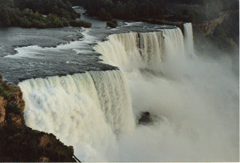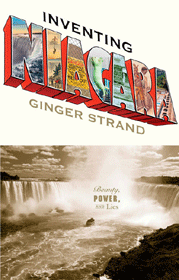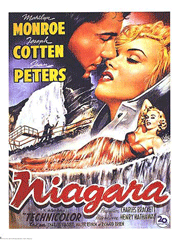Inventing Niagara
Air Date: Week of July 18, 2008

(Photo: John Hackston)
Niagara Falls might be one of the most photographed waterfalls in the world, but Ginger Strand, author of the new book "Inventing Niagara: Beauty, Power, and Lies," says there's much more than meets the eye. Living on Earth's host Bruce Gellerman talks with Strand about our long and often bizarre relationship with the "natural" wonder.
Transcript
GELLERMAN: It’s Living on Earth. I’m Bruce Gellerman. Niagara Falls: the name comes from the Iroquois Indian word meaning: thunder of waters. And thunder it does…
[SOUNDS FROM NIAGRA FALLS – WATER THUNDERING]
GELLERMAN: Three quarters of a million gallons of water a second cascades over Niagara; one fifth of the world’s fresh water flows over the falls. It’s an awe-inspiring site: the falls’ natural beauty and hydroelectric energy competing forces that over the years have attracted honeymooners and developers, daredevils and corporate polluters. The story of the history and transformation of the falls is told by Ginger Strand in her new book: “Inventing Niagara: Beauty, Power, and Lies.”

STRAND: I think that’s true, yeah. There are pictures of it everywhere, right. And there’s a sense in which it is the iconic American landscape in that you haven’t been to America until you’ve seen the falls.
GELLERMAN: But it’s interesting that something so awesome and something so magnificent can have so little that’s genuine about it. They try to control just about everything, they try to control not just the water going over but the mist.
STRAND: That’s right. This is what fascinated me overall at every step of the way it was a kind of contest between humans and nature and you know we were always stacking the deck. The international control structure that’s upstream of the falls people look at that and they think that it has something to do with water diversion, it helps water go into the tunnels or something. It has nothing to do with water diversion, it’s just to redirect the water to make the falls look pretty.

(Photo: John Hackston)
STRAND: Mhmm. There’s a lot of rocky rubble—they call it tallis—at the base of the American falls, and the Army Corps of Engineers decided, in their infinite wisdom, that they should clear all those rocks away because they’re really not very pretty and people would rather see the waterfall looking bigger and more muscular. So they turned off the falls, and they drilled core samples and studied the whole rock face and they realized that if they took the rocky rubble away the whole thing would collapse. It’s actually holding up the waterfall. So they changed their mind about that.
GELLERMAN: I want to ask you about daredevils. Niagara Falls of course is synonymous with people who are walking tightropes, and people going over it in a barrel. There was a guy named Blondon, did I pronounce that correctly?
STRAND: Yes. Yes.
GELLERMAN: And he actually carries somebody, his manager, on his back as he’s walking across the wire.
STRAND: On a tightrope yeah. And what Blondon was doing was to some extent a commentary on the upcoming Civil War and the Underground Railroad. You know, Niagara Falls was one of the key crossing points into Canada for fugitive slaves. And the only place where they could get across to Canada that was serviced by public transportation was Niagara. They could take a train ride up and they could go across the bridge or they could row across the river. And this was just, it was a national spectacle throughout the 1800s but especially the 1850s. People were crossing on a daily basis into Canada. And everyone was fascinated by this. And it’s 1859, 1860 when Blondon does his famous tightrope performances at the falls and he does them in shackles, and he does them with a sack over his head, and he does them in the middle of the night with a sack over his head. I mean, they’re incredible performances but I also began to think, “Wow, this guy was making a sly but pointed comment.”
GELLERMAN: Tell me about Annie Taylor. How old is she when she goes over the falls in a barrel?
STRAND: She was 63. She lied, she said she was 43, but she was 63. An unemployed dancing teacher from Bay City, Michigan and she was the first person to survive going over the horseshoe in a barrel.

Ginger Strand. (Photo: Orianna Riley, Courtesy of Simon & Schuster)
GELLERMAN: How did Niagara Falls become the honeymoon capital of the world?
STRAND: Well the honeymoon is not as old an institution as we tend to think it is. It kind of got going as a popular thing to do in the early 1800s and that was about the same time that Niagara became accessible. It became accessible in 1825 when the Erie Canal arrived nearby and people could suddenly get up there conveniently. So Niagara became the sort of peak, the sort of climax of the American Grand Tour, they called it the Northern Tour.
GELLERMAN: Of course it really got a boost when Marilyn Monroe starred in “Niagara.”
STRAND: Yes, absolutely.
[MARIYLN MONROE SINGING “TAKE ME TAKE ME IN YOUR ARMS”]
STRAND: When Marilyn came in 1952 and they filmed “Niagara” it became an epidemic at the fall—everybody called up and they wanted to stay at the hotel that Marilyn stayed in, which of course didn’t exist, it was a set.

GELLERMAN: And of course it was Dupont, the chemical company, which was responsible for so much of the toxic waste that wound up getting dumped into the river and therefore over the falls.
STRAND: That’s right, Dupont, and Hooker, and ElectroMet, UnionCarbide—a whole slew of the American electrochemical industry was centered at Niagara Falls for many, many years.
GELLERMAN: Right, HookerChemical of course with Love Canal.
STRAND: Yes, it was appalling and it went on for decades, the dumping. It was an abandoned hydroelectric canal begun many, many years earlier where just all sorts of things were dumped and I think they identified 82 separate chemicals when they finally did begin testing that were leaking into peoples basements and showing up on playgrounds, children were turning up with strange burns. There were miscarriages and birth defects.
[SOUNDS FROM A NEWS REPORT ON TOXIC WASTE]
STRAND: And many people are familiar with Love Canal as the beginning of the Environmental Justice movement. This is when people began to talk about where these places are sited and the kinds of working-class people who tend to bear the burdens of hazardous waste. But few people realize that it’s actually a stone’s throw from the Niagara River so this toxic brew was going over the falls.

Love Canal residents protest the toxic waste dump. (Courtesy of the Environmental Protection Agency)
STRAND: [Laughs] Yes, one of the creepier things that’s buried there but certainly not the only one. They had the capacity to do uranium diffusion at Niagara Falls because there were all of these chemical companies who had been experimenting with uranium already, the electrometallurgical companies had the ability to roll the uranium into rods to be used in nuclear reactors. So they did all that work at the falls. There are actually 13 sites that are now being cleared up by the Army Corps of Engineers as former Manhattan Project contractors in the county. And you know it all boils down to our human drive to master the waterfall and in 1895 they really did that. They, you know, Tesla and Westinghouse managed to harness the falls and utilized the massive amounts of electricity that they could produce and from then on, Niagara became the site of all the industries that were interested in cheap electricity. So electrochemical, electrometallurgical, anyone who used electricity in manufacturing their product. And at that time there were no regulations about disposing of waste, whether it was hazardous waste or just normal waste, and so it just got dumped all over town.
GELLERMAN: So what’s the lesson of Niagara Falls’ history?
STRAND: I think that the lesson of Niagara is that you really can’t separate human history from natural history. And we have this funny notion of nature as this thing that’s out there, and it’s kind of separate from us, and we’re either going to use it or we’re going to deify it, put it on a pedestal and look at it and say, “Oh isn’t it beautiful.” And I think that the reality of the way we live in the environment is much more complicated than that. For instance, with the water diversion of Niagara, I’m not against hydrodiversion, I think hydro’s relatively benign when it comes to ways that we produce electricity, but it does have a price. And I’m fascinated that we are so interested in disguising that price because it makes it that much harder for us to know when the price is becoming too high.
GELLERMAN: Well Ginger it’s been a real pleasure. Thanks very much.
STRAND: It’s been my pleasure.
GELLERMAN: Ginger Strand is the author of the new book "Inventing Niagara: Beauty, Power, and Lies.”
Links
Living on Earth wants to hear from you!
Living on Earth
62 Calef Highway, Suite 212
Lee, NH 03861
Telephone: 617-287-4121
E-mail: comments@loe.org
Newsletter [Click here]
Donate to Living on Earth!
Living on Earth is an independent media program and relies entirely on contributions from listeners and institutions supporting public service. Please donate now to preserve an independent environmental voice.
NewsletterLiving on Earth offers a weekly delivery of the show's rundown to your mailbox. Sign up for our newsletter today!
 Sailors For The Sea: Be the change you want to sea.
Sailors For The Sea: Be the change you want to sea.
 The Grantham Foundation for the Protection of the Environment: Committed to protecting and improving the health of the global environment.
The Grantham Foundation for the Protection of the Environment: Committed to protecting and improving the health of the global environment.
 Contribute to Living on Earth and receive, as our gift to you, an archival print of one of Mark Seth Lender's extraordinary wildlife photographs. Follow the link to see Mark's current collection of photographs.
Contribute to Living on Earth and receive, as our gift to you, an archival print of one of Mark Seth Lender's extraordinary wildlife photographs. Follow the link to see Mark's current collection of photographs.
 Buy a signed copy of Mark Seth Lender's book Smeagull the Seagull & support Living on Earth
Buy a signed copy of Mark Seth Lender's book Smeagull the Seagull & support Living on Earth

